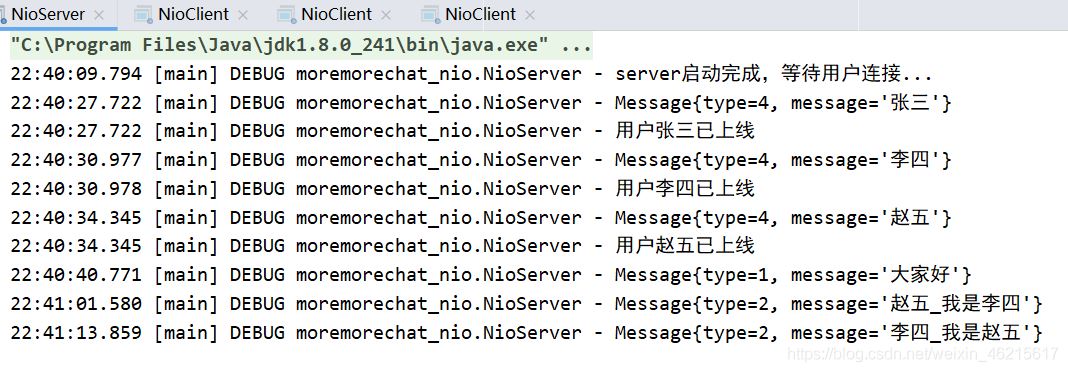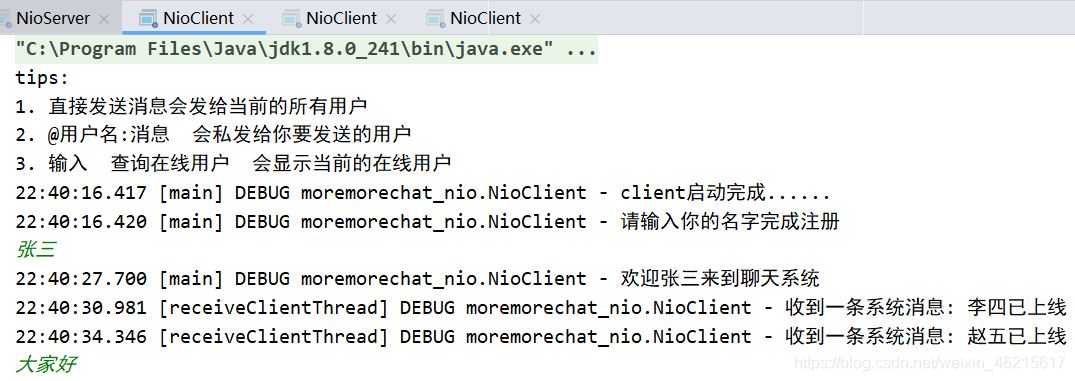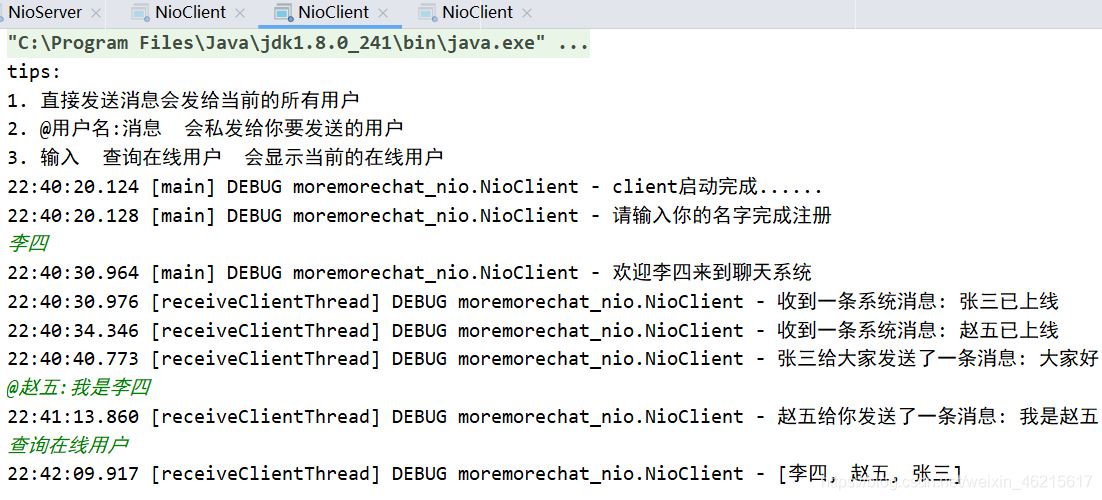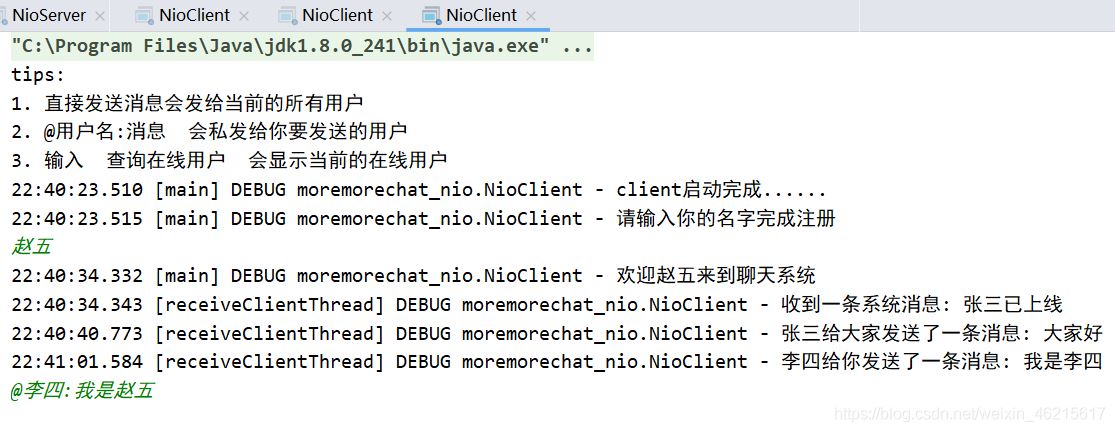жӮЁеҘҪпјҢзҷ»еҪ•еҗҺжүҚиғҪдёӢи®ўеҚ•е“ҰпјҒ
жӮЁеҘҪпјҢзҷ»еҪ•еҗҺжүҚиғҪдёӢи®ўеҚ•е“ҰпјҒ
иҝҷзҜҮж–Үз« з»ҷеӨ§е®¶еҲҶдә«зҡ„жҳҜжңүе…іJavaжҖҺд№Ҳе®һзҺ°NIOиҒҠеӨ©е®Өзҡ„еҶ…е®№гҖӮе°Ҹзј–и§үеҫ—жҢәе®һз”Ёзҡ„пјҢеӣ жӯӨеҲҶдә«з»ҷеӨ§е®¶еҒҡдёӘеҸӮиҖғпјҢдёҖиө·и·ҹйҡҸе°Ҹзј–иҝҮжқҘзңӢзңӢеҗ§гҖӮ
еҠҹиғҪ:зҫӨиҒҠ+з§ҒеҸ‘+дёҠзәҝжҸҗйҶ’+дёӢзәҝжҸҗйҶ’+жҹҘиҜўеңЁзәҝз”ЁжҲ·




йңҖиҰҒз”ЁmavenеҜје…ҘдёӢйқўдёӨдёӘеҢ…
<dependency> <groupId>org.projectlombok</groupId> <artifactId>lombok</artifactId> <version>1.16.18</version> </dependency> <dependency> <groupId>ch.qos.logback</groupId> <artifactId>logback-classic</artifactId> <version>1.2.3</version> </dependency>
package moremorechat_nio; import lombok.extern.slf4j.Slf4j; import java.io.*; /** * @author mazouri * @create 2021-05-09 22:26 */ @Slf4j public class Utils { /** * е°ҶдәҢиҝӣеҲ¶ж•°жҚ®иҪ¬дёәеҜ№иұЎ * * @param buf * @return * @throws IOException * @throws ClassNotFoundException */ public static Message decode(byte[] buf) throws IOException, ClassNotFoundException { ByteArrayInputStream bais = new ByteArrayInputStream(buf); ObjectInputStream ois = new ObjectInputStream(bais); return (Message) ois.readObject(); } /** * е°ҶеҜ№иұЎиҪ¬дёәдәҢиҝӣеҲ¶ж•°жҚ® * * @param message * @return */ public static byte[] encode(Message message) throws IOException { ByteArrayOutputStream baos = new ByteArrayOutputStream(); ObjectOutputStream oos = new ObjectOutputStream(baos); oos.writeObject(message); oos.flush(); return baos.toByteArray(); } }package moremorechat_nio; /** * @author mazouri * @create 2021-05-05 21:00 */ public final class FinalValue { /** * зі»з»ҹж¶ҲжҒҜ */ public static final int MSG_SYSTEM = 0; /** * зҫӨеҸ‘ж¶ҲжҒҜ */ public static final int MSG_GROUP = 1; /** * з§ҒеҸ‘ж¶ҲжҒҜ */ public static final int MSG_PRIVATE = 2; /** * е®ўжҲ·з«ҜиҜ·жұӮеңЁзәҝдәәе‘ҳ */ public static final int MSG_ONLINE = 3; /** * е®ўжҲ·з«Ҝе°Ҷз”ЁжҲ·еҗҚз§°еҸ‘йҖҒз»ҷжңҚеҠЎз«Ҝ */ public static final int MSG_NAME = 4; }package moremorechat_nio; import java.io.Serializable; /** * @author mazouri * @create 2021-05-05 21:00 */ public class Message implements Serializable { public int type; public String message; public Message() { } public Message(String message) { this.message = message; } public Message(int type, String message) { this.type = type; this.message = message; } @Override public String toString() { return "Message{" + "type=" + type + ", message='" + message + '\'' + '}'; } }package moremorechat_nio; import lombok.extern.slf4j.Slf4j; import java.io.*; import java.net.InetSocketAddress; import java.nio.ByteBuffer; import java.nio.channels.*; import java.util.ArrayList; import java.util.Iterator; import java.util.Set; import java.util.concurrent.atomic.AtomicBoolean; import java.util.stream.Collectors; import static moremorechat_nio.FinalValue.*; /** * ctrl+f12 ж–№жі• * ctrl+alt+е·Ұй”® * @author mazouri * @create 2021-05-09 19:24 */ @Slf4j public class NioServer { private Selector selector; private ServerSocketChannel ssc; public NioServer() { try { // еҲӣе»ә selector, з®ЎзҗҶеӨҡдёӘ channel selector = Selector.open(); //жү“ејҖServerSocketChannelпјҢз”ЁдәҺзӣ‘еҗ¬е®ўжҲ·з«Ҝзҡ„иҝһжҺҘпјҢе®ғжҳҜжүҖжңүе®ўжҲ·з«ҜиҝһжҺҘзҡ„зҲ¶йҖҡйҒ“ ssc = ServerSocketChannel.open(); ssc.bind(new InetSocketAddress(8888)); //и®ҫзҪ®иҝһжҺҘдёәйқһе өеЎһжЁЎејҸ ssc.configureBlocking(false); // 2. е»әз«Ӣ selector е’Ң channel зҡ„иҒ”зі»пјҲжіЁеҶҢпјү // SelectionKey е°ұжҳҜе°ҶжқҘдәӢ件еҸ‘з”ҹеҗҺпјҢйҖҡиҝҮе®ғеҸҜд»ҘзҹҘйҒ“дәӢ件е’Ңе“ӘдёӘchannelзҡ„дәӢ件 //е°ҶServerSocketChannelжіЁеҶҢеҲ°ReactorзәҝзЁӢзҡ„еӨҡи·ҜеӨҚз”ЁеҷЁSelectorдёҠпјҢзӣ‘еҗ¬ACCEPTдәӢ件 ssc.register(selector, SelectionKey.OP_ACCEPT); } catch (IOException e) { e.printStackTrace(); } } public static void main(String[] args) { NioServer server = new NioServer(); log.debug("serverеҗҜеҠЁе®ҢжҲҗпјҢзӯүеҫ…з”ЁжҲ·иҝһжҺҘ..."); try { server.listen(); } catch (Exception e) { log.debug("еҸ‘з”ҹдәҶдёҖдәӣй—®йўҳ"); } } /** * зӣ‘еҗ¬з”ЁжҲ·зҡ„иҝһжҺҘ * * @throws Exception */ private void listen() throws Exception { while (true) { // select ж–№жі•, жІЎжңүдәӢ件еҸ‘з”ҹпјҢзәҝзЁӢйҳ»еЎһпјҢжңүдәӢ件пјҢзәҝзЁӢжүҚдјҡжҒўеӨҚиҝҗиЎҢ, йҖҡиҝҮSelectorзҡ„selectпјҲпјүж–№жі•еҸҜд»ҘйҖүжӢ©е·Із»ҸеҮҶеӨҮе°ұз»Әзҡ„йҖҡйҒ“ пјҲиҝҷдәӣйҖҡйҒ“еҢ…еҗ«дҪ ж„ҹе…ҙи¶Јзҡ„зҡ„дәӢ件пјү //йҖҡиҝҮSelectorзҡ„selectпјҲпјүж–№жі•еҸҜд»ҘйҖүжӢ©е·Із»ҸеҮҶеӨҮе°ұз»Әзҡ„йҖҡйҒ“ пјҲиҝҷдәӣйҖҡйҒ“еҢ…еҗ«дҪ ж„ҹе…ҙи¶Јзҡ„зҡ„дәӢ件пјү // select еңЁдәӢ件жңӘеӨ„зҗҶж—¶пјҢе®ғдёҚдјҡйҳ»еЎһ, дәӢ件еҸ‘з”ҹеҗҺиҰҒд№ҲеӨ„зҗҶпјҢиҰҒд№ҲеҸ–ж¶ҲпјҢдёҚиғҪзҪ®д№ӢдёҚзҗҶ selector.select(); // еӨ„зҗҶдәӢ件, selectedKeys еҶ…йғЁеҢ…еҗ«дәҶжүҖжңүеҸ‘з”ҹзҡ„дәӢ件 Iterator<SelectionKey> iterator = selector.selectedKeys().iterator(); while (iterator.hasNext()) { SelectionKey key = iterator.next(); // еӨ„зҗҶkey ж—¶пјҢиҰҒд»Һ selectedKeys йӣҶеҗҲдёӯеҲ йҷӨпјҢеҗҰеҲҷдёӢж¬ЎеӨ„зҗҶе°ұдјҡжңүй—®йўҳ iterator.remove(); // еҢәеҲҶдәӢ件зұ»еһӢ if (key.isAcceptable()) { ServerSocketChannel channel = (ServerSocketChannel) key.channel(); SocketChannel sc = channel.accept(); sc.configureBlocking(false); sc.register(selector, SelectionKey.OP_READ); } else if (key.isReadable()) { dealReadEvent(key); } } } } /** * еӨ„зҗҶиҜ»дәӢ件 * * @param key */ private void dealReadEvent(SelectionKey key) { SocketChannel channel = null; try { channel = (SocketChannel) key.channel(); ByteBuffer buffer = ByteBuffer.allocate(1024); int read = channel.read(buffer); // еҰӮжһңжҳҜжӯЈеёёж–ӯејҖпјҢread зҡ„ж–№жі•зҡ„иҝ”еӣһеҖјжҳҜ -1 if (read == -1) { //cancel дјҡеҸ–ж¶ҲжіЁеҶҢеңЁ selector дёҠзҡ„ channelпјҢ并д»Һ keys йӣҶеҗҲдёӯеҲ йҷӨ key еҗҺз»ӯдёҚдјҡеҶҚзӣ‘еҗ¬дәӢ件 key.cancel(); } else { buffer.flip(); Message msg = Utils.decode(buffer.array()); log.debug(msg.toString()); dealMessage(msg, key, channel); } } catch (IOException | ClassNotFoundException e) { System.out.println((key.attachment() == null ? "еҢҝеҗҚз”ЁжҲ·" : key.attachment()) + " зҰ»зәҝдәҶ.."); dealMessage(new Message(MSG_SYSTEM, key.attachment() + " зҰ»зәҝдәҶ.."), key, channel); //еҸ–ж¶ҲжіЁеҶҢ key.cancel(); //е…ій—ӯйҖҡйҒ“ try { channel.close(); } catch (IOException ioException) { ioException.printStackTrace(); } } } /** * еӨ„зҗҶеҗ„з§Қж¶ҲжҒҜпјҢ并еҸ‘йҖҒз»ҷе®ўжҲ·з«Ҝ * * @param msg * @param key * @param channel */ private void dealMessage(Message msg, SelectionKey key, SocketChannel channel) { switch (msg.type) { case MSG_NAME: key.attach(msg.message); log.debug("з”ЁжҲ·{}е·ІдёҠзәҝ", msg.message); getConnectedChannel(channel).forEach(selectionKey -> { SocketChannel sc = (SocketChannel) selectionKey.channel(); sendMsgToClient(new Message("收еҲ°дёҖжқЎзі»з»ҹж¶ҲжҒҜ: " + msg.message + "е·ІдёҠзәҝ"), sc); }); break; case MSG_GROUP: getConnectedChannel(channel).forEach(selectionKey -> { SocketChannel sc = (SocketChannel) selectionKey.channel(); sendMsgToClient(new Message(key.attachment() + "з»ҷеӨ§е®¶еҸ‘йҖҒдәҶдёҖжқЎж¶ҲжҒҜ: " + msg.message), sc); }); break; case MSG_PRIVATE: String[] s = msg.message.split("_"); AtomicBoolean flag = new AtomicBoolean(false); getConnectedChannel(channel).stream().filter(sk -> s[0].equals(sk.attachment())).forEach(selectionKey -> { SocketChannel sc = (SocketChannel) selectionKey.channel(); sendMsgToClient(new Message(key.attachment() + "з»ҷдҪ еҸ‘йҖҒдәҶдёҖжқЎж¶ҲжҒҜ: " + s[1]), sc); flag.set(true); }); if (!flag.get()){ sendMsgToClient(new Message(s[1]+"з”ЁжҲ·дёҚеӯҳеңЁ,иҜ·йҮҚж–°иҫ“е…ҘпјҒпјҒпјҒ"), channel); } break; case MSG_ONLINE: ArrayList<String> onlineList = new ArrayList<>(); onlineList.add((String) key.attachment()); getConnectedChannel(channel).forEach(selectionKey -> onlineList.add((String) selectionKey.attachment())); sendMsgToClient(new Message(onlineList.toString()), channel); break; case MSG_SYSTEM: getConnectedChannel(channel).forEach(selectionKey -> { SocketChannel sc = (SocketChannel) selectionKey.channel(); sendMsgToClient(new Message("收еҲ°дёҖжқЎзі»з»ҹж¶ҲжҒҜ: " + msg.message), sc); }); break; default: break; } } /** * еҸ‘йҖҒж¶ҲжҒҜз»ҷе®ўжҲ·з«Ҝ * * @param msg * @param sc */ private void sendMsgToClient(Message msg, SocketChannel sc) { try { byte[] bytes = Utils.encode(msg); sc.write(ByteBuffer.wrap(bytes)); } catch (IOException e) { log.debug("sendMsgToClientеҮәзҺ°дәҶдёҖдәӣй—®йўҳ"); } } /** * иҺ·еҸ–жүҖжңүchannel,йҷӨеҺ»и°ғз”ЁиҖ… * * @param channel * @return */ private Set<SelectionKey> getConnectedChannel(SocketChannel channel) { return selector.keys().stream() .filter(item -> item.channel() instanceof SocketChannel && item.channel().isOpen() && item.channel() != channel) .collect(Collectors.toSet()); } }package moremorechat_nio; import lombok.extern.slf4j.Slf4j; import java.io.*; import java.net.InetSocketAddress; import java.nio.ByteBuffer; import java.nio.channels.SelectionKey; import java.nio.channels.Selector; import java.nio.channels.SocketChannel; import java.util.Iterator; import java.util.Scanner; import static moremorechat_nio.FinalValue.*; /** * @author mazouri * @create 2021-04-29 12:02 */ @Slf4j public class NioClient { private Selector selector; private SocketChannel socketChannel; private String username; private static Scanner input; public NioClient() throws IOException { selector = Selector.open(); socketChannel = SocketChannel.open(new InetSocketAddress("127.0.0.1", 8888)); socketChannel.configureBlocking(false); socketChannel.register(selector, SelectionKey.OP_READ); log.debug("clientеҗҜеҠЁе®ҢжҲҗ......"); log.debug("иҜ·иҫ“е…ҘдҪ зҡ„еҗҚеӯ—е®ҢжҲҗжіЁеҶҢ"); input = new Scanner(System.in); username = input.next(); log.debug("ж¬ўиҝҺ{}жқҘеҲ°иҒҠеӨ©зі»з»ҹ", username); } public static void main(String[] args) throws IOException { System.out.println("tips: \n1. зӣҙжҺҘеҸ‘йҖҒж¶ҲжҒҜдјҡеҸ‘з»ҷеҪ“еүҚзҡ„жүҖжңүз”ЁжҲ· \n2. @з”ЁжҲ·еҗҚ:ж¶ҲжҒҜ дјҡз§ҒеҸ‘з»ҷдҪ иҰҒеҸ‘йҖҒзҡ„з”ЁжҲ· \n3. иҫ“е…Ҙ жҹҘиҜўеңЁзәҝз”ЁжҲ· дјҡжҳҫзӨәеҪ“еүҚзҡ„еңЁзәҝз”ЁжҲ·"); NioClient client = new NioClient(); //еҗҜеҠЁдёҖдёӘеӯҗзәҝзЁӢжҺҘеҸ—жңҚеҠЎеҷЁеҸ‘йҖҒиҝҮжқҘзҡ„ж¶ҲжҒҜ new Thread(() -> { try { client.acceptMessageFromServer(); } catch (Exception e) { e.printStackTrace(); } }, "receiveClientThread").start(); //и°ғз”ЁsendMessageToServer,еҸ‘йҖҒж¶ҲжҒҜеҲ°жңҚеҠЎз«Ҝ client.sendMessageToServer(); } /** * е°Ҷж¶ҲжҒҜеҸ‘йҖҒеҲ°жңҚеҠЎз«Ҝ * * @throws IOException */ private void sendMessageToServer() throws IOException { //е…ҲжҠҠз”ЁжҲ·еҗҚеҸ‘з»ҷе®ўжҲ·з«Ҝ Message message = new Message(MSG_NAME, username); byte[] bytes = Utils.encode(message); socketChannel.write(ByteBuffer.wrap(bytes)); while (input.hasNextLine()) { String msgStr = input.next(); Message msg; boolean isPrivate = msgStr.startsWith("@"); if (isPrivate) { int idx = msgStr.indexOf(":"); String targetName = msgStr.substring(1, idx); msgStr = msgStr.substring(idx + 1); msg = new Message(MSG_PRIVATE, targetName + "_" + msgStr); } else if ("жҹҘиҜўеңЁзәҝз”ЁжҲ·".equals(msgStr)) { msg = new Message(MSG_ONLINE, "иҜ·жұӮеңЁзәҝдәәж•°"); } else { msg = new Message(MSG_GROUP, msgStr); } byte[] bytes1 = Utils.encode(msg); socketChannel.write(ByteBuffer.wrap(bytes1)); } } /** * жҺҘеҸ—д»ҺжңҚеҠЎеҷЁеҸ‘йҖҒиҝҮжқҘзҡ„ж¶ҲжҒҜ */ private void acceptMessageFromServer() throws Exception { while (selector.select() > 0) { Iterator<SelectionKey> iterator = selector.selectedKeys().iterator(); while (iterator.hasNext()) { SelectionKey key = iterator.next(); iterator.remove(); if (key.isReadable()) { SocketChannel sc = (SocketChannel) key.channel(); ByteBuffer buffer = ByteBuffer.allocate(1024); sc.read(buffer); Message message = Utils.decode(buffer.array()); log.debug(String.valueOf(message.message)); } } } } }Javaзҡ„еҹәжң¬ж•°жҚ®зұ»еһӢеҲҶдёәпјҡ1гҖҒж•ҙж•°зұ»еһӢпјҢз”ЁжқҘиЎЁзӨәж•ҙж•°зҡ„ж•°жҚ®зұ»еһӢгҖӮ2гҖҒжө®зӮ№зұ»еһӢпјҢз”ЁжқҘиЎЁзӨәе°Ҹж•°зҡ„ж•°жҚ®зұ»еһӢгҖӮ3гҖҒеӯ—з¬Ұзұ»еһӢпјҢеӯ—з¬Ұзұ»еһӢзҡ„е…ій”®еӯ—жҳҜвҖңcharвҖқгҖӮ4гҖҒеёғе°”зұ»еһӢпјҢжҳҜиЎЁзӨәйҖ»иҫ‘еҖјзҡ„еҹәжң¬ж•°жҚ®зұ»еһӢгҖӮ
ж„ҹи°ўеҗ„дҪҚзҡ„йҳ…иҜ»пјҒе…ідәҺвҖңJavaжҖҺд№Ҳе®һзҺ°NIOиҒҠеӨ©е®ӨвҖқиҝҷзҜҮж–Үз« е°ұеҲҶдә«еҲ°иҝҷйҮҢдәҶпјҢеёҢжңӣд»ҘдёҠеҶ…е®№еҸҜд»ҘеҜ№еӨ§е®¶жңүдёҖе®ҡзҡ„её®еҠ©пјҢи®©еӨ§е®¶еҸҜд»ҘеӯҰеҲ°жӣҙеӨҡзҹҘиҜҶпјҢеҰӮжһңи§үеҫ—ж–Үз« дёҚй”ҷпјҢеҸҜд»ҘжҠҠе®ғеҲҶдә«еҮәеҺ»и®©жӣҙеӨҡзҡ„дәәзңӢеҲ°еҗ§пјҒ
е…ҚиҙЈеЈ°жҳҺпјҡжң¬з«ҷеҸ‘еёғзҡ„еҶ…е®№пјҲеӣҫзүҮгҖҒи§Ҷйў‘е’Ңж–Үеӯ—пјүд»ҘеҺҹеҲӣгҖҒиҪ¬иҪҪе’ҢеҲҶдә«дёәдё»пјҢж–Үз« и§ӮзӮ№дёҚд»ЈиЎЁжң¬зҪ‘з«ҷз«ӢеңәпјҢеҰӮжһңж¶үеҸҠдҫөжқғиҜ·иҒ”зі»з«ҷй•ҝйӮ®з®ұпјҡis@yisu.comиҝӣиЎҢдёҫжҠҘпјҢ并жҸҗдҫӣзӣёе…іиҜҒжҚ®пјҢдёҖз»ҸжҹҘе®һпјҢе°Ҷз«ӢеҲ»еҲ йҷӨж¶үе«ҢдҫөжқғеҶ…е®№гҖӮ